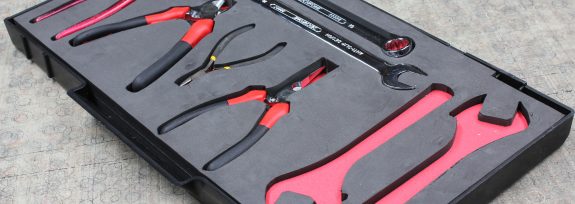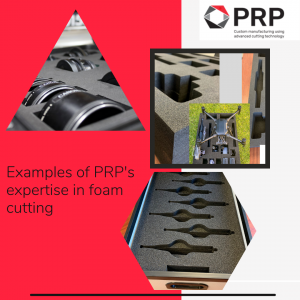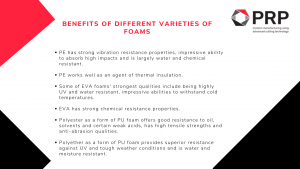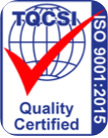What is PRP’s foam cutting and foam shaping service?

Foam is a versatile material that can be cut and shaped in numerous ways. It is used for many different purposes, such as for insulation (thermal and sound), gaskets and seals, packaging, and protection (from drones and fragile camera equipment, all the way to weapons and military-related applications). With custom CNC foam cutting being one of PRP’s primary capabilities, it has consistently delivered strong results in fulfilling the diverse needs of its customers in this area.
Firstly, it is important to understand some of the foams used in the CNC cutting industry and what differentiates one from another. The properties of foam are what generally decides its use case. PE or polyethylene, EVA or ethylene-vinyl acetate, and PU or polyurethane (comprising of Polyester and Polyether) primarily make up the different kinds of foams that PRP specialises in.
Overall foams consist of mainly closed or open cell varieties, further divided into cross-linked (XL) and non-cross-linked variations. Open-cell foams have characteristics that allow water and air to flow through easily, while closed-cell foams are good at resisting moisture absorption. Specialised cross-linked (XL) varieties can be useful in cases requiring low thermal conductivity, high melting points, and strong insulating properties. Non-cross-linked on the other hand can be cheaper than their XL counterparts, good for products demanding a lower melting point, or in applications when a product could require an easier means for recyclability.
Below are some examples that highlight the ways foam can be cut and shaped for different purposes according to the needs of customers.

What are some of the characteristics of PE foam and how can it be used to cater to your different needs?
PE is a low-density lightweight foam that generally falls under the closed-cell category, and can be cross-linked (XL) or non-cross linked in structure. It is one that is used widely in CNC cutting because of its unique characteristics. Moreover, it has strong vibration resistance, impressive ability to absorb high impacts, and is largely water and chemical resistant. It also has numerous use cases for thermal insulation.
Some of its applications as part of a CNC cutting service might include shaping, profiling, and routering, to create foam inserts for storing a wide range of equipment, such as sensitive optical instruments for defence, through to photographic lenses and tools. PRP also works with various case manufacturers such as Pelican.
As PE is such a versatile material, there are many other uses for shaping PE foam across a diverse range of industrial sectors. PRP is always passionate about chatting with both current and future customers to help them understand the uses of PE foam and to support them with any technical requirements or specifications.

Do you think EVA foam has similar characteristics to PE or does it have different use cases?
In general, EVA consists of a closed-cell structure and has a broader density range than PE (30 kg/m^3-400kg/m^3). The greater elongation-at-break percentage of EVA (the amount of deformation a material experiences before breaking), further acts as a differentiating factor between PE. EVA foam cutting services (like PE foam cutting) is widely used in the CNC cutting industry because of its versatility and variety of applications.
Some of EVA’s strongest attributes include being highly UV and water resistant, having an impressive ability to withstand cold temperatures (as low as -70° Celsius), and strong properties relating to chemical resistance. EVA foams can be desirable for cushioning and provide long-term durability for products such as seat cushions and foam gaskets. Because of its strong characteristics, EVA is widely used as an agent for flooring underlay which makes it an integral part of the construction industry. In addition, it is a material that is popularly used in medical, toys, and sporting goods.

What are the different types of Polyurethane (PU) foams?
PU foams can be divided into two categories – Polyester and Polyether. Although both are PU foams, they have distinct characteristics which can be summarised below.
Polyesters have characteristics that give great resistance to oil, solvents and certain weak acids. They have high tensile strengths and anti-abrasion qualities. Its weaknesses include poor protection against UV and harsh weather conditions, and poor resistance against moisture. In contrast to this, polyether provides superior resistance against UV and tough weather conditions, and is water and moisture resistant. However, polyether is generally much weaker in tensile strength than polyester.
PU foams experience a large range of elastic deformation under stress, which is why they are used for mattresses and cushioning in chairs. They can have an open or closed cell structure. PU foams are used as an insulating agent for doors, some electrical appliances, and in buildings.
The above article highlights some of the differences between PU, PE and EVA foams. With PRP’s versatility and our diverse range of skills, knowledge and capabilities, we consistently strive to exceed the needs of our customers and provide solutions over a wide variety of different industrial sectors.
